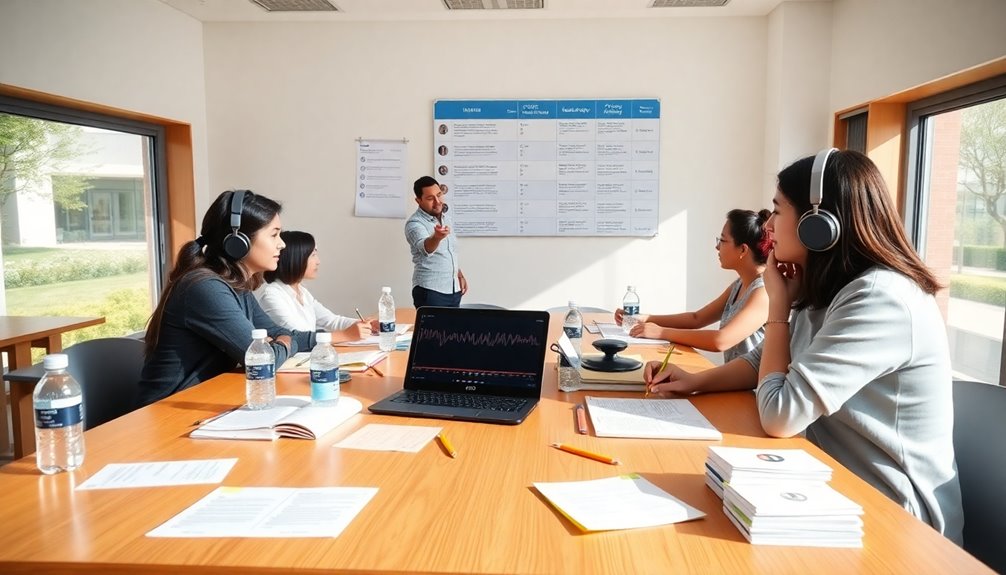
You can choose from language academies, private tutors, online platforms, or blended schools that focus specifically on TOEIC. They give targeted practice, realistic mock exams, and test-taking strategies to boost your score. Look for courses with certified teachers, adaptive materials, and progress tracking. Group classes build timing and interaction skills, while one-on-one lessons fix weak spots faster. Compare costs, schedules, and alumni results to find the best fit, and keep going to learn how to pick the right program.
Why Choose a School That Specializes in TOEIC
If you want to raise your TOEIC score efficiently, choosing a school that specializes in the test gives you targeted practice, expert strategies, and materials aligned with the exam format. You’ll gain a specialized curriculum that strips away irrelevant content and focuses on the question types, timing, and vocabulary that matter. With expert instructors guiding you, you’ll adopt shortcuts and test-taking habits that save time and reduce stress. You’ll feel freer to plan study around your life because the program’s structure accelerates progress—so you don’t need endless hours. Expect regular, measurable improvements and feedback that pinpoints weak spots. Choosing a specialist school helps you use your study time deliberately, reach your score goals faster, and keep control over your learning journey.
Types of Schools Offering TOEIC Preparation
When you’re choosing a TOEIC prep program, you’ll find several school types—each with different strengths, formats, and price points—so pick one that matches your schedule, learning style, and target score. You’ll want freedom to learn on your terms, so consider how each option fits your lifestyle and goals. Look for transparent curriculum options and flexible pacing.
- Language academies: structured schedules, clear school types, group classes or intensive tracks for steady progress.
- Online platforms: maximal freedom, self-paced modules, diverse curriculum options and live tutor add-ons.
- Private tutors or small studios: tailored plans, flexible timings, focused practice for specific score aims.
Choose the type that gives you autonomy, consistent feedback, and a clear path to your TOEIC goal.
Curriculum Features That Boost TOEIC Scores
You’ll want a curriculum that focuses on targeted skill drilling to shore up your weakest areas and build speed. It should teach practical test-taking strategies so you can handle question types and time pressure confidently. Look for courses using realistic practice materials that mirror TOEIC format and difficulty.
Targeted Skill Drilling
Because the TOEIC tests specific, repeatable skills rather than general English ability, targeted skill drilling focuses your practice on the exact question types and micro-skills that raise scores—like quick skimming, detail listening, and error spotting—so you spend less time guessing and more time improving measurable performance. You’ll get targeted feedback and ongoing skill assessment so you know what to repeat and what to drop, giving you freedom to study efficiently and control your progress. Drills are short, intense, and repeatable, fitting into a flexible schedule that respects your life.
- Timed micro-drills for speed and accuracy.
- Focused listening repeats with transcript comparison.
- Error-spotting cycles plus corrective review.
Test-Taking Strategies
Although test knowledge won’t replace practice, mastering smart test-taking strategies will help you turn skills into higher TOEIC scores by cutting avoidable mistakes, pacing your sections, and choosing the best answers under pressure. You’ll learn brief routines to calm test anxiety, time checkpoints to avoid rushing, and motivation techniques that keep you moving toward freedom to score well. Instructors show guesswork tactics, elimination methods, and focused reading for economy. Use these strategies to control your exam experience, not be controlled by it.
| Strategy | Benefit | Quick Tip |
|---|---|---|
| Elimination | Raises accuracy | Cross out unlikely answers |
| Chunking | Improves pacing | Set mini-deadlines |
| Skimming | Saves time | Read questions first |
| Calm routine | Reduces anxiety | Breath for 30s |
| Motivation cue | Sustains effort | Reward milestones |
Realistic Practice Materials
Smart test-taking habits set the stage, but nothing beats practicing with materials that mirror the real TOEIC. You’ll gain confidence when you work with authentic materials that mimic timing, format, and language level. Choose exercises rooted in real world scenarios so you can apply skills freely—reading signs, following phone messages, or handling workplace emails.
- Full-length, timed practice tests that replicate exam conditions.
- Task-based exercises drawn from business meetings, customer interactions, and travel situations.
- Listening drills using varied accents and natural speech from real conversations.
When your practice feels like the real thing, you’ll perform without second-guessing. Schools that prioritize this approach let you learn efficiently and keep your options open for study, work, or travel.
Qualified Teachers and Their TOEIC Experience

Great teachers make all the difference when you’re preparing for the TOEIC: they combine certified training, real test experience, and targeted strategies to boost your score. You want instructors whose teacher qualifications are clear—degrees, teaching licenses, and proven TOEIC certifications—so you can trust guidance that’s both professional and practical. Look for teachers who’ve taken recent exams, coached diverse learners, and share actionable tips you can apply right away. They should explain exam patterns, timing tactics, and common traps without dictating rigid study paths, letting you choose methods that fit your lifestyle. When teachers balance credentials with flexible coaching, you gain confidence and control over progress, moving toward higher scores while keeping your study freedom intact.
Course Formats: Group, Private, and Blended Options
You’ll choose between group classes that build interaction and timing, one-on-one tutoring tailored to your weaknesses, or a blended model that mixes both for flexibility. Group sessions sharpen listening and speaking under time pressure, while private lessons let you focus on specific grammar and test strategies. Blended courses give you structured practice plus personalized feedback so you get the best of both worlds.
Group Class Structure
Often a mixed-format approach gives you the best balance of interaction and targeted feedback: group classes build listening and speaking fluency through peer activities and real-time discussions, while private sessions let you focus on specific weaknesses, and blended courses combine both so you get classroom energy plus individualized guidance. In group class structure you’ll appreciate varied pacing and peer accountability; check class size and teacher ratio to guarantee attention. Expect rotating tasks, timed practice, and review cycles that mimic TOEIC timing so you can manage stress and pace on test day.
- Role plays and group drills boost conversational stamina and quick comprehension.
- Small groups keep feedback personal while preserving peer dynamics.
- Scheduled mock tests with group review sharpen scoring strategies and time management.
One-On-One Tutoring
If group classes sharpen your timing and conversational flow, one-on-one tutoring targets the exact skills holding you back and gets you there faster. You’ll get personalized lessons focused on your weak spots—listening, reading speed, or tricky grammar—so every minute moves you closer to your target TOEIC score. Because you value freedom, private sessions adapt to your life: flexible scheduling lets you pick times that suit travel, work, or peak study energy. Your tutor adjusts pace and materials, giving immediate feedback and strategies you can apply independently. Expect progress checks and tailored practice that respect your goals and time. If you want efficiency and control over your preparation, private tutoring delivers direct, measurable results.
Blended Learning Model
Because everyone learns differently and your schedule might change week to week, a blended learning model mixes group classes, private tutoring, and self-study so you get structure, personalization, and flexibility in one program. You’ll join lively group sessions to practice fast thinking, use private lessons to focus on weak spots, and tap online resources whenever you want to review or accelerate. This setup lets you control pace, keep commitments, and avoid rigid timetables.
- Tailored feedback: private tutoring pinpoints errors; group work builds fluency.
- Flexible access: recorded lessons and online resources fit unpredictable days.
- Efficient progression: self-study modules let you skip familiar material and push ahead.
Choose this blend when you value autonomy and measurable TOEIC gains.
Intensive vs. Long-Term TOEIC Programs
When you’re deciding between an intensive TOEIC course and a long-term program, think about how quickly you need results and how much time you can realistically commit; intensive courses cram focused practice and rapid feedback into weeks, while long-term programs spread learning out to build steady habits and deeper skills. You’ll pick intensive programs if you want fast gains, a strict schedule, and the freedom to finish quickly and move on. Choose long term programs if you prefer flexible pacing, gradual improvement, and lasting retention that fits a liberated lifestyle. Balance your current routine, stress tolerance, and target score. Either route can lead to success; the key is selecting the format that matches your need for control and time autonomy.
Practice Materials and Mock Test Availability

You’ll want to check whether a school offers extensive practice banks that cover all TOEIC question types. Also ask about access to full-length mock exams under timed conditions to mirror test day. Regular, realistic practice will show you where to focus your study.
Extensive Practice Banks
If you want to raise your TOEIC score efficiently, extensive practice banks give you the focused exposure you need: thousands of curated questions, varied task types, and full-length mock tests that mirror real exam timing and scoring. You’ll access extensive practice resources that let you target weak spots, practice freely, and build confidence without feeling boxed in. Adaptive learning tools personalize question difficulty, so you progress at your own pace and keep momentum. Choose a school whose banks update regularly and let you replay problem types or skip ahead when you master a section. Look for clear analytics, timed drills, and topic tagging so you can design your own study path.
- Question variety and tagging
- Personalized difficulty adjustments
- Progress analytics and replay options
Full-Length Mock Exams
After you’ve worked through varied question banks and tracked weak spots, full-length mock exams let you bring it all together under realistic conditions. You’ll experience timed sections, authentic pacing, and the pressure that mirrors test day so you can learn to manage time and nerves. Schools offering these full length assessments usually provide score reports, error analyses, and targeted review sessions, so you’re not just taking tests but refining strategy. Choose programs that let you repeat simulations and compare progress across attempts; that freedom helps you craft a personalized plan. For efficient exam preparation, look for availability of proctored and at-home mocks, clear feedback, and flexible scheduling so you can practice when it suits your life.
Listening Skills Training Methods

Effective listening training mixes focused practice, real-world exposure, and strategic feedback so you can improve comprehension and test performance. You’ll use interactive listening tasks and targeted audio comprehension drills that mirror TOEIC formats, letting you build accuracy and confidence without feeling boxed in. Coaches encourage autonomy, so you’ll choose topics that spark curiosity and freedom to explore accents, speeds, and contexts. Short, repeated sessions sharpen attention; varied voices prevent reliance on patterns. Regular feedback pinpoints weak spots so you can adjust practice quickly.
- Practice varied clips: dialogues, announcements, and short talks with progressive difficulty.
- Shadowing and note-taking: replicate rhythm and capture key details under time pressure.
- Error analysis: review mistakes, identify patterns, and customize follow-up exercises.
Reading and Time-Management Strategies
Listening practice sharpens your ear for tone, speed, and detail, and you’ll now apply that same focus to reading with strategies that save time and boost accuracy. You’ll learn skimming for main ideas, scanning for keywords, and prioritizing passages that yield the most points. Lessons emphasize reading comprehension through targeted question practice, inference drills, and vocabulary in context so you can decide fast what to read deeply. Teachers show you how to chunk texts, set micro-deadlines, and skip traps without guilt — essential time management habits for exam freedom. You’ll practice pacing with timed sections, review error patterns, and build confidence to tackle sections selectively. These skills let you control the test, not be controlled by it.
Use of Technology and Online Platforms
While you keep sharpening reading and timing skills, embrace technology and online platforms to expand practice, track progress, and simulate test conditions. You’ll find online resources and digital tools that let you study anywhere, set your pace, and choose which skills to focus on, giving you the freedom to design your prep. Use platforms that mirror TOEIC formats so you get comfortable with real timing and question types.
Embrace tech: use adaptive apps and cloud tests to practice anywhere, track progress, and mimic real TOEIC timing.
- Adaptive practice modules that adjust difficulty and replicate exam timing.
- Mobile apps for bite-sized drills and listening practice during commutes.
- Cloud-based practice tests you can schedule, pause, and review on your terms.
Pick tools that respect your independence and help you train efficiently without rigid routines.
Progress Tracking and Personalized Feedback

Because steady progress matters, you should track your scores and review detailed feedback after each practice session so you can spot weak points and adjust your study plan. You’ll appreciate schools that use clear progress assessments and adaptive feedback mechanisms, giving you autonomy to choose focus areas and pace. Personalized reports highlight grammar, listening, and timing, and coaches suggest compact drills you can fit into a flexible life. Below is a simple snapshot of how schools present progress so you can compare quickly.
| Area | Score Trend | Suggested Focus |
|---|---|---|
| Listening | +4 | Speed and inference |
| Reading | −2 | Skimming, vocab |
| Grammar | +1 | Error patterns |
| Timing | −3 | Pacing practice |
Pricing, Schedules, and Enrollment Policies
When comparing schools, look closely at total cost, what’s included, and refund or makeup-class policies so you won’t get surprised by extra fees or strict schedules. You want flexibility: check tuition costs per term, whether materials or mock tests are extra, and if part-time options exist so you can keep control of your time. Ask about schedule ranges and evening or weekend classes that fit your life.
- Clear cancellation and refund terms — free or low-cost changes protect your freedom.
- Flexible scheduling and makeups — guarantee you can reschedule without penalties.
- Straightforward enrollment process — quick online signup, transparent prerequisites, and clear start dates.
Know these details before committing so the program matches your priorities.
How to Evaluate and Compare TOEIC Schools
How do you pick the right TOEIC school among many similar-sounding options? Start by clarifying your goals—score target, timeline, and study style—so you can judge fit, not hype. Check school reputation through verified rankings, accreditations, and alumni outcomes. Read student testimonials but watch for generic praise; prioritize specific mentions of score gains, teaching methods, and instructor responsiveness. Compare curricula: balance of listening, reading, test strategies, and practice tests. Evaluate flexibility—class formats, make-up policies, and resources for independent study—to protect your freedom to learn on your terms. Consider trial lessons or short packages to test quality before committing. Finally, weigh cost against measurable results; choose the school that best matches your goals and lifestyle.
Some Questions Answered
Do Schools Offer Official TOEIC Test Administration On-Site?
Yes — you can: picture a carriage rolling up as you learn that many schools offer on site testing and handle test registration for official TOEIC sessions, so you’ll choose freedom to book and sit where you’re comfortable.
Can Non-Native Staff Provide Effective TOEIC Instruction?
Yes — you can get excellent results from non-native staff; their non native effectiveness often stems from clear teaching strategies, empathy, and exam familiarity, so you’ll enjoy adaptable lessons that respect your independence and learning choices.
Are Scholarships or Financial Aid Available for TOEIC Courses?
Yes — you can find scholarship options and financial assistance for TOEIC courses; you’ll often qualify via school programs, government grants, employer support, or nonprofit bursaries, letting you pursue prep freely without burdening your budget.
Do Schools Assist With Post-Test Job Placement Using TOEIC Scores?
Yes — many schools quietly open doors to opportunities, and you’ll find they blend test preparation with career services so you can leverage TOEIC scores for job placement, mentorship, and networking as you pursue greater freedom.
What Accommodations Exist for Test-Takers With Disabilities?
You’ll get accessibility options like extended time, separate rooms, screen readers, and alternate formats; test taker support includes documentation help, accommodations requests, and on-site assistance so you’re empowered to take the TOEIC fairly and freely.
